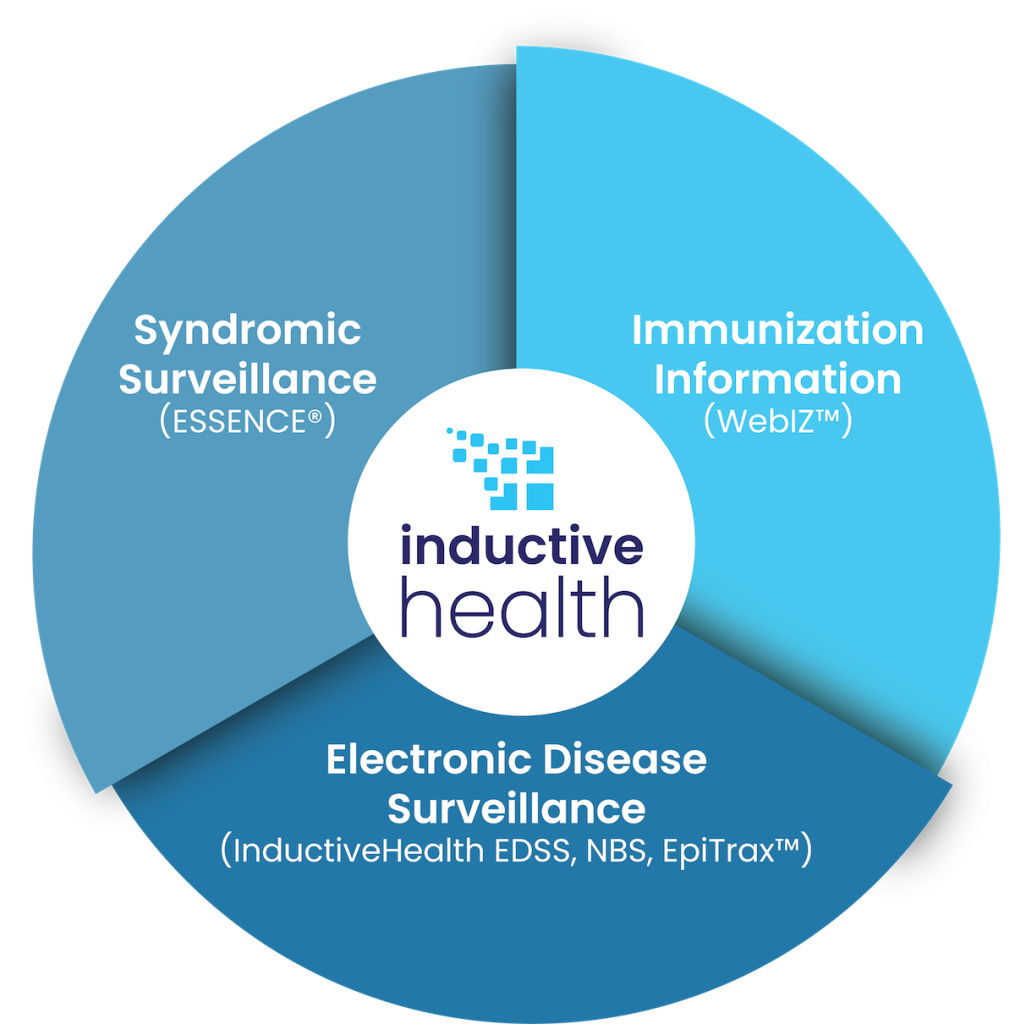InductiveHealth is a company that provides cloud-based public health data integration, disease surveillance, and syndromic surveillance for government health agencies. Pulse 2.0 interviewed InductiveHealth Chief Executive Officer Eric Whitworth to gain a deeper understanding of the company.
Eric Whitworth’s Background

Could you tell me more about your background? Whitworth said:
“I attended the University of Georgia and have degrees in political science and history. After graduation, I spent the early part of my career in risk management and government compliance with a specialization in health care and government. My work revolved around compliance and data security, working between local jurisdictions, with states, and with the federal government. So, when I made the connection with InductiveHealth, which was looking for a leader to take the business forward, my knowledge about working with local, state, and federal governments, as well as my skill set and background in health data, was ideal to make the leap into public health.”
Formation Of The Company
How did the idea for the company come together? Whitworth shared:
“Years ago, InductiveHealth’s co-founders, Matthew Dollacker and Stephen Macauley worked on portions of the original National Electronic Disease Surveillance System initiative (NEDSS), which is led by the Centers for Disease Control and Prevention (CDC). The goal of this initiative was to create and promote a national network of public health surveillance systems that track and report instances of diseases that must be submitted to the CDC. However, Matt and Stephen realized a gap: States didn’t have a direct method to host, support, upgrade, and maintain the system that the CDC created and released. So, their value proposition for InductiveHealth was to create a way to support that system for state public health departments to host, support, and maintain the NEDSS system as the CDC has evolved it. Since that time, InductiveHealth has grown to become the only company whose solutions support states and jurisdictions across all three pillars of public health technology: electronic disease monitoring, syndromic surveillance, and immunization information systems.”
Favorite Memory
What has been your favorite memory working for the company so far? Whitworth reflected:
“My favorite aspect of InductiveHealth is the deep commitment of my colleagues. The team at InductiveHealth is comprised of public health experts, including many epidemiologists and public health technologists, who care deeply about their mission. For those who work in public health, it isn’t a job, it’s a calling. It is a calling to serve the public through research and disease prevention. And their commitment and unwavering dedication to protect communities, states, and our country through disease and syndromic surveillance creates such a positive impact. I couldn’t be prouder to work alongside people who are so dedicated to what they do and the people they serve.”
Core Products

What are the company’s core products and features? Whitworth explained:
“The mission of InductiveHealth, which is proud to work with over 40 state, local, territorial, and tribal public health departments, is stopping disease through technology. We provide data infrastructure, surveillance, and intervention solutions for public health departments. We are the only public health technology provider that offers syndromic surveillance, electronic disease surveillance, and immunization information systems as one powerful platform to help jurisdictions track and analyze multiple data streams, identify troubling trends, and quickly take action to mitigate threats to public health in their communities.”
Challenges Faced
Have you faced any challenges in your sector of work recently? Whitworth acknowledged:
“While Covid, and the post-Covid era, has been a challenge for everyone in public health, the dedication of our colleagues and our partnerships with jurisdictions has proven to be deeply rewarding, and we are all proud to help shape the path of public health.”
“Today, InductiveHealth is engaged in public policy to hold conversations with the Administration and Congress about real-world observations from the frontlines to ensure our nation’s public health infrastructure is strong and able to keep communities healthy. We’re seeing that the rapidly shifting dynamic in public health is making it more difficult for public health departments to plan, chart the correct course, and commit to a specific path forward. But just as we did during Covid, the commitment of those who have dedicated their careers to keeping communities healthy is the fuel that will help us all ultimately improve the public health infrastructure.”
Evolution Of The Company’s Technology
How has the company’s technology evolved since launching? Whitworth noted:
“Everything in public health now is around modernization. But modernization is not singular, and it is not the same for everyone in public health. Regardless of whether you are at the federal, state, territorial, tribal, or local level, leaders need to assess their current capabilities and goals. If you modernize your capabilities, what does that mean? To me, modernization means improving your public health infrastructure to meet the needs of your community.”
“To help public health departments modernize their data infrastructure, we’ve evolved more toward Software as a Service (SaaS) cloud-based hosting concepts. We’re helping public health departments move away from “on premises” data centers and deep custom development to more configurable technology standards that can be scaled faster and more cost effectively. We must keep costs down for our clients. Funding resources are finite, so being cloud-hosted, scalable, and able to modify the system without costly development is paramount. Making our systems more modular, rather than static, has been a big focus of our recent work.”
Significant Milestones
What have been some of the company’s most significant milestones? Whitworth cited:
“Our partnership with Johns Hopkins University’s Applied Physics Lab, which gives us the capability to conduct syndromic surveillance along with disease surveillance, has been a significant milestone. Secondly, the acquisition of Envision Technology Partners last year, which added the third pillar of immunization information systems into our capabilities, has been another significant development that has enabled us to be a true public health partner to jurisdictions and offer more flexibility and choice with their technology solutions.”
Customer Success Stories
When asking Whitworth about customer success stories, he highlighted:
“We partnered with the Missouri Department of Health and Senior Services to modernize and improve syndromic surveillance data collection and reporting. Three key take aways from our work are:
- Missouri’s public health department came to us to modernize their syndromic surveillance data collection and reporting efforts to help promote public health.
- Having a partner like InductiveHealth can help public health departments keep their systems and processes up to date to improve data accuracy and completion, while maintaining accreditation with the Public Health Accreditation Board.
- We are proud to go above and beyond to help clients meet their data collection, reporting, and modernization needs.
Through its participation in the National Syndromic Surveillance Program (NSSP), Missouri is required to collect and report syndromic surveillance data to monitor illness and injury trends, detect and characterize outbreaks, and evaluate public health responses. However, the Missouri Department of Health and Senior Services (DHSS) reporting system needed updating to enhance data quality, improve completeness, and detect unusual patterns in a timelier, more efficient manner. Missouri’s data also lacked validity and completeness for Priority 1 and 2 data elements, thereby failing to meet minimum NSSP requirements.
By working with us to modernize their local ESSENCE system, Missouri DHSS strengthened their interoperability to ensure seamless data exchange between different systems while improving the speed, accuracy, and scope of surveillance to enable faster, more effective public health responses statewide.
After launching their new-and-improved system, Missouri saw significant improvements in data quality standards and reporting procedures, which have led to more reliable, consistent data being available for analysis. By integrating syndromic surveillance data with other health information systems, Missouri is now able to get a more comprehensive view of public health events and better understand resource needs. This makes data timelier and more useful for decision-making.”
Funding/Revenue
When asking Whitworth about the company’s funding and revenue details, he revealed:
“On average, states receive approximately 70 percent of their public health funding from the federal government, and public health funding has increased year-over-year for the past twenty years to meet the public health needs in communities. And yet, while most of the public health funding originates at the federal level, public health needs are inherently local. Public health runs through communities, not the federal government. So, InductiveHealth needs to be flexible, configurable, and scalable to bring communities solutions that fit their needs based on their resources.”
Total Addressable Market
What total addressable market (TAM) size is the company pursuing? Whitworth assessed:
“The total addressable market for InductiveHealth is public health departments in all 50 states, the top 15 largest cities and counties based on population, the U.S. territories, and tribes.”
Differentiation From The Competition
What differentiates the company from its competition? Whitworth affirmed:
“Our multi-offering ability in public health technology. While most companies in our space focus on a single public health technology, we are the only provider that offers a platform across all three pillars of public health – disease surveillance, syndromic surveillance, and immunization information systems.”
Future Company Goals
What are some of the company’s future goals? Whitworth emphasized:
“Our top priority is to partner with all our jurisdictional clients to use all three of our solutions – disease surveillance, syndromic surveillance, and immunization systems. We believe that the ability to bring the solutions together for hosting, service, and maintenance is superior technologically as it allows jurisdictions to scale faster and overlay and combine data sets in ways not previously possible. Not only does this provide insights that weren’t available, but it can also lead to significant cost savings. Economies of scale matter in an industry like public health because funding is limited. So, the ability to cross sell what we do in different jurisdictions and prove that we have the best technology in all three public health data infrastructure pillars is a benefit for both InductiveHealth and our clients.”
Additional Thoughts
Any other topics you would like to discuss? Whitworth concluded:
“Public health technology will continue to change dramatically over the next few years. AI is certainly going to have a big impact – for example, how it will help outbreak management, disease prevention, contact tracing, patient outreach, and data sharing. The answers to these questions will define the public health landscape over the next decade or more.”


